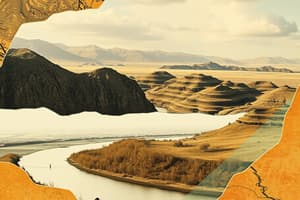Podcast
Questions and Answers
What is Sequent Occupance?
What is Sequent Occupance?
Successive societies leave their cultural imprints on a place that add up to the cultural landscape.
What is a Cultural Landscape?
What is a Cultural Landscape?
The fashioning of natural landscape by a culture group to fit their needs.
What is Arithmetic Density?
What is Arithmetic Density?
Total number of people divided by total area of land.
What is Physiological Density?
What is Physiological Density?
What does Hearth refer to?
What does Hearth refer to?
What is Diffusion?
What is Diffusion?
What is Relocation Diffusion?
What is Relocation Diffusion?
What is Expansion Diffusion?
What is Expansion Diffusion?
What is Hierarchical Diffusion?
What is Hierarchical Diffusion?
What is Contagious Diffusion?
What is Contagious Diffusion?
What is Absolute Distance?
What is Absolute Distance?
What is Relative Distance?
What is Relative Distance?
What does Distribution mean?
What does Distribution mean?
What is Environmental Determinism?
What is Environmental Determinism?
What is Stimulus Diffusion?
What is Stimulus Diffusion?
What is Absolute Location?
What is Absolute Location?
What is Relative Location?
What is Relative Location?
What is Site?
What is Site?
What is Situation?
What is Situation?
What does Space Time Compression refer to?
What does Space Time Compression refer to?
What is Friction of Distance?
What is Friction of Distance?
What is Distance Decay?
What is Distance Decay?
What are Networks?
What are Networks?
What does Connectivity mean?
What does Connectivity mean?
What is Accessibility?
What is Accessibility?
What is Space?
What is Space?
What is Spatial Distribution?
What is Spatial Distribution?
What does Size refer to in geography?
What does Size refer to in geography?
What is Scale?
What is Scale?
What is a Formal Region?
What is a Formal Region?
What is a Functional Region?
What is a Functional Region?
What is a Vernacular Region?
What is a Vernacular Region?
What is Possibilism?
What is Possibilism?
What is Natural Landscape?
What is Natural Landscape?
What does Pattern refer to in geography?
What does Pattern refer to in geography?
What is a Place Name?
What is a Place Name?
Study Notes
Key Vocabulary and Definitions
-
Sequent Occupance: Represents how successive societies shape and modify the cultural landscape, illustrating human-environment interactions over time.
-
Cultural Landscape: The result of the transformation of the natural landscape by cultural groups to meet their needs.
-
Arithmetic Density: Calculated by dividing the total population by the total land area, indicating population distribution per unit of land.
-
Physiological Density: Measures the number of people per unit of arable land, highlighting land usage relative to population.
-
Hearth: The original region where innovative ideas or practices originate.
-
Diffusion: The process of spreading cultural features and practices from one location to others over time.
-
Relocation Diffusion: The transmission of cultural elements through the physical movement of people from one place to another.
-
Expansion Diffusion: Features spread through a snowballing effect, occurring in hierarchical, contagious, or stimulus forms.
-
Hierarchical Diffusion: Spreading of ideas or trends from a person of authority to other individuals or places.
-
Contagious Diffusion: Rapid and widespread diffusion of a characteristic through a population.
-
Absolute Distance: Precise measurement between two geographical locations.
-
Relative Distance: Approximate measurement reflecting the distance between two places in a broader context.
-
Distribution: The arrangement and spread of various phenomena across the Earth's surface.
-
Environmental Determinism: The theory that human activities are influenced and shaped by the physical environment.
-
Stimulus Diffusion: Spread of an underlying principle or idea even if the specific characteristic does not fully diffuse.
-
Absolute Location: The exact geographical coordinates determined by latitude and longitude.
-
Relative Location: Location defined in relation to other landmarks or geographical features.
-
Site: The intrinsic characteristics and significance of a specific location.
-
Situation: A location described in relation to other places.
-
Space Time Compression: The phenomenon where advancements in technology reduce the time it takes for ideas to spread.
-
Friction of Distance: The concept that increased distance requires greater effort, money, or energy, leading to more frequent interactions over shorter distances.
-
Distance Decay: The principle that interaction decreases as the distance between groups increases.
-
Networks: A system of interconnected nodes without a central hub.
-
Connectivity: The various relationships that exist across distances, transcending geographical barriers.
-
Accessibility: The ease of reaching a location from other places.
-
Space: The physical gap or interval between two objects.
-
Spatial Distribution: Examination of how phenomena are located across various areas.
-
Size: An estimation of the extent or magnitude of a geographical feature.
-
Scale: The representation of real-world phenomena, adjusted for reduction or generalization.
-
Formal Region: A defined area where one or more distinctive characteristics, like language or climate, are uniformly shared among its inhabitants.
-
Functional Region: Organized around a central node or focal point, influencing the surrounding area.
-
Vernacular Region: A perceptual area recognized by the local population as part of their cultural identity.
-
Possibilism: The idea that while the environment may impose certain limitations on human actions, people can adapt and modify their environments.
-
Natural Landscape: Geographic features created by natural processes over time.
-
Pattern: The geometric arrangement or common property of distribution among objects in space.
-
Place Name: Known as toponym, it refers to the designated name given to a particular location on Earth.
Studying That Suits You
Use AI to generate personalized quizzes and flashcards to suit your learning preferences.
Description
Test your knowledge with this quiz on key terms from Chapter 1 of AP Human Geography. Understand concepts like Sequent Occupance and Cultural Landscape, and how they relate to human interaction with the environment. Perfect for review before your exam!




